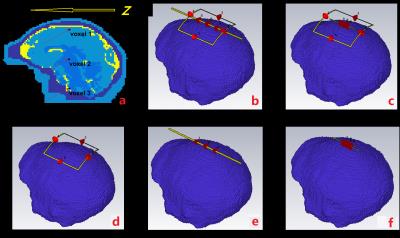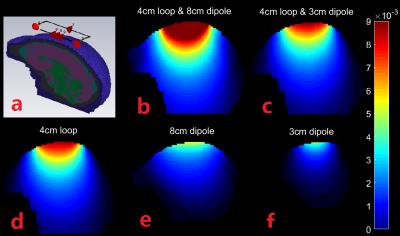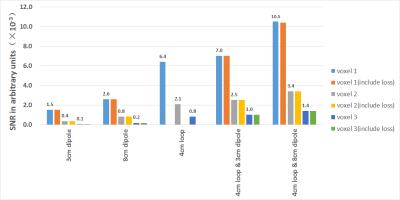4286
Mixed Dipole and Loop Coil for Macaque Brain Imaging at 7T: A Simulation Study1Interdisciplinary Institute of Neuroscience and Technology, Zhejiang University, Hangzhou, People's Republic of China, 2College of Biomedical Engineering & Instrument Science, Zhejiang University, Hangzhou, People's Republic of China, 3Center for Magnetic Resonance Research, University of Minnesota, Minneapolis, United States, 4MR Collaboration Northeast Asia, Siemens Healthcare, Shanghai, People's Republic of China
Synopsis
For monkey brain functional MR imaging, sufficient SNR is essential to reveal significant functional activities. Through a series of numerical simulation, we have demonstrated that under 7T environment, to image macaque brain whose size is much smaller than the natural resonate dimension of a dipole antenna, combining dipole and loop can feasibly provide considerably high SNR in both local cortical and deep brain regions. It is believed that such design will effectively benefit functional MRI over macaque with much enhanced signal quality.
Introduction
For monkey brain functional MR imaging, sufficient SNR is essential to reveal functional activities. Recently, combining loop element with dipole antenna with increased number of total channels has been proposed and actively pursued, and such design has demonstrated much higher SNR in the center of human body-sized object[1,2] as well as in human head phantom[3]. Such findings have also been endorsed by the theory of ultimate intrinsic signal-to-noise ratio (UISNR), illustrating that higher SNR can be achieved with both divergence-free and curl-free current components than what a single component can possibly provide [4]. Up to now, dipole antenna is generally considered having better performance for large object (as compared to the size of a macaque head), whereas in this study, through a series of numerical simulation, we explore whether mixed dipole and loop can achieve higher SNR within the macaque brain.Method
FDTD simulations have been performed with CST Microwave studio 2016 (Darmstadt, Germany). All coil elements were modeled on a cylindrical surface 0.5cm above a macaque head model with an isotropic resolution of 1mm (Fig. 1). The macaque head model, consisting of five types of tissues (scalp, skull, WM, GM, and CSF, as shown in Fig. 1a), was reconstructed through manual tissue segmentation over 1mm isotropic MPRAGE T1w images acquired from a Siemens 7T Scanner (Erlangen, Germany). The dielectric properties of each tissue were set to be the same values of corresponding human head tissue. Two types of mixed dipole and loop coils were simulated for comparison. Fig. 1b and 1c show an 8cm-in-length dipole element (the same with the dimension of the monkey head along z-axis) and a 3cm dipole element, both were centered over a rectangular loop element of 4cm×4cm in dimension, respectively. The same loop and dipoles were simulated separately for comparison purposes, as shown in Fig. 1d, 1e, and 1f, respectively. All coil elements were tuned to 297.2 MHz, matched, and decoupled through co-simulation. Dipole elements were tuned with inductors close to the feed points. It is known that the inductors for shortened dipoles (< λ/2) will introduce extra resistance into the coil, especially for very small dipole; therefore, simulations with additional resistance calculated through a Q value (~20) provided by the manufacture of non-magnetic inductors were repeated.Results
A sagittal slice of interest was chosen through the center of the macaque head model (Fig. 2a). The spatial distribution of SNR is visualized in Fig. 2b-f. For all coil configurations, the SNR exponentially decreases from the top towards the bottom of the head. In Fig. 3, we compared SNR for three different brain regions with different depths (as shown in Fig. 1a). The mixed 4cm loop and 8cm dipole configuration results in the highest SNR at all depths, while the mixed coil configuration with shorter dipole (3cm) produced 2nd highest SNR and slightly higher than 4cm single-loop coil. For all single-element coils, 4cm loop has better SNR performance than dipoles at both superficial and deep brain areas. Note that the modeled inductance loss caused trivial effects on the SNR.Discussion
The results showed that small dipole alone is ineffective to reach high SNR. The mixed dipole (8cm) and loop array provides 62.5% and 61.9% higher SNR at cortex (voxel 1) and central brain area (voxel 2), respectively, as compared to the 4cm single-element loop coil; whereas mixed array with 3cm dipole only showed 9.4% and 19.5% higher SNR at cortex and central brain area, respectively, as compared to the same loop coil. Combining dipole antenna and loop coil offers better SNR gain in the central area than periphery, which is consistent with previous studies [1,2]. It should be noted that, only one dipole and/or loop have been modeled in this study, providing us with valuable insights in their performance over small subject imaging. For real macaque imaging, a number of dipole antennas and loop coils can be utilized to form a multiple-channel coil array, and by using such array, considerably high SNR can be anticipated in both local cortical regions and deep brain regions.Conclusion
Through a series of numerical simulation, we have demonstrated that under 7T environment, for macaque brain whose size is much smaller than the natural resonate dimension of a dipole antenna, combining dipole and loop can feasibly provide considerably high SNR in both local cortical regions and deep brain regions. It is believed that such design will effectively benefit functional MR imaging over macaque with much enhanced signal quality.Acknowledgements
We would like to thank Dr. Gregor Adriany for useful discussion. This work was supported in part by National Natural Science Foundation of China (31471052), Fundamental Research Funds for the Central Universities (2015QN81007, 2016QN81018), and Zhejiang Provincial Natural Science Foundation of China (LR15C090001). This work was supported in part by National Natural Science Foundation of China (31471052), Fundamental Research Funds for the Central Universities (2015QN81007, 2016QN81018), and Zhejiang Provincial Natural Science Foundation of China (LR15C090001).References
[1]. Wiggins, G.C., et al., Mixing loops and electric dipole antennas for increased sensitivity at 7 Tesla, in Proc. Intl. Soc. Mag. Reson. Med. 21. 2013. p. 2737.
[2]. Erturk, M.A., et al., A 16-channel combined loop-dipole transceiver array for 7 Tesla body MRI. Magn Reson Med, 2016.
[3]. Gang Chen, K.L.D.S., A combined electric dipole and loop head coil for 7T head imaging, in Proc. Intl. Soc. Mag. Reson. Med. 23. 2015. p. 3133.
[4]. Lattanzi, R. and D.K. Sodickson, Ideal current patterns yielding optimal SNR and SAR in magnetic resonance imaging: computational methods and physical insights. Magn Reson Med , 2012. 68(1): p. 286-304.
Figures


